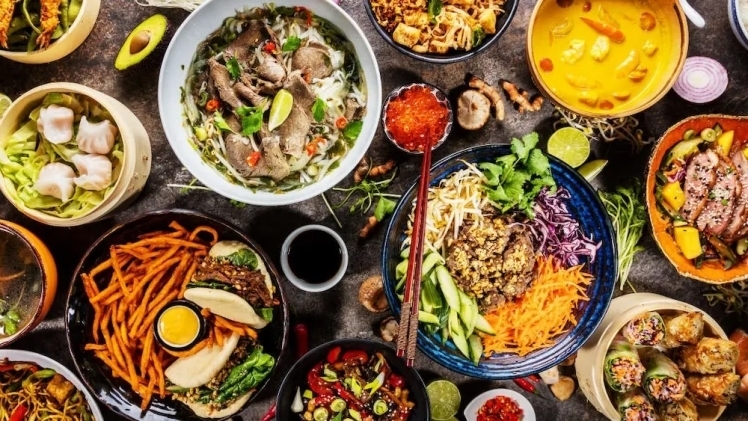Food, beyond its fundamental role as sustenance, is a dynamic and intricate tapestry woven with flavors, traditions, and cultural significance. It transcends the mere act of eating, becoming a celebration of diversity, a source of comfort, and a medium through which communities express their identity. In this exploration of the world of food, we delve into the richness of culinary experiences, the artistry of cooking, and the communal nature of sharing meals.
The Artistry of Cooking:
At the heart of the culinary world lies the artistry of cooking, where chefs and home cooks alike transform raw ingredients into delectable creations. Cooking is a creative process that combines flavors, textures, and techniques to elevate the simple act of eating into a multisensory experience. From the precision of fine dining to the warmth of home-cooked meals, the art of cooking bridges cultures and generations, leaving an indelible mark on the memories we create around the table.
Culinary Diversity:
One of the most remarkable aspects of food is its ability to reflect the diversity of cultures and regions. Each cuisine tells a story, rooted in the history, geography, and traditions of a community. From the spicy and vibrant dishes of Southeast Asia to the hearty and comforting flavors of Italian cuisine, the world of food is a global tapestry, woven with a myriad of spices, ingredients, and culinary techniques.
Exploring diverse cuisines not only expands our palates but also fosters a deeper understanding and appreciation for different cultures. Food acts as a universal language, breaking down barriers and inviting individuals to share in the rich heritage of global culinary traditions.
The Ritual of Sharing Meals:
Food is a conduit for social interaction, bringing people together in the shared ritual of meals. Whether it’s a family dinner, a festive celebration, or a casual gathering with friends, the act of sharing meals fosters connections, strengthens relationships, and creates lasting memories.
The dining table becomes a sacred space where stories are exchanged, laughter is shared, and relationships are nurtured. The communal aspect of food extends beyond mere nourishment; it is a celebration of togetherness, where people bond over a shared love for flavors and a collective appreciation for the art of cooking.
The Culinary Journey:
In an era of globalization, the culinary world has become a dynamic and ever-evolving landscape. Food enthusiasts embark on culinary journeys, exploring diverse cuisines, experimenting with fusion flavors, and embracing the farm-to-table movement. The rise of food tourism reflects a growing appreciation for the cultural and gastronomic experiences that different regions have to offer.
Cooking shows, food blogs, and social media platforms contribute to the democratization of culinary knowledge. Individuals are empowered to experiment in their own kitchens, sharing recipes, and creating a virtual community of food enthusiasts who celebrate the joy of cooking and eating.
Health and Wellness in the Culinary World:
The relationship between food and health has garnered increased attention, leading to a shift in culinary trends. People are becoming more conscious of the nutritional value of their meals, seeking a balance between indulgence and well-being. The emphasis on fresh, organic, and locally sourced ingredients reflects a growing awareness of the impact of food choices on both personal health and the environment.
Innovations in the culinary world include plant-based diets, mindful eating practices, and a focus on functional foods that offer health benefits beyond basic nutrition. The intersection of culinary arts and health consciousness is reshaping the way individuals approach food, promoting holistic well-being.
Food as a Cultural Identifier:
Food serves as a powerful identifier of cultural identity, preserving traditions and conveying a sense of belonging. Traditional recipes passed down through generations become cultural legacies, connecting individuals to their heritage. Festivals and special occasions often revolve around signature dishes that hold cultural and emotional significance.
The fusion of cuisines in multicultural societies further exemplifies the fluid and adaptive nature of food culture. Culinary innovation emerges as diverse ingredients and cooking techniques are interwoven, creating unique and hybrid dishes that reflect the ever-evolving cultural landscape.
Sustainable and Ethical Eating:
As awareness of environmental issues grows, the culinary world is witnessing a shift towards sustainable and ethical eating practices. Consumers are increasingly concerned about the sourcing of ingredients, the ecological footprint of food production, and the ethical treatment of animals. This consciousness has led to the rise of sustainable seafood initiatives, farm-to-table movements, and a focus on reducing food waste.
Chefs and food establishments are championing sustainability by incorporating locally sourced, seasonal ingredients into their menus, adopting eco-friendly practices, and raising awareness about the impact of food choices on the planet. The culinary world plays a pivotal role in advocating for a more sustainable and ethical approach to food consumption.
Conclusion:
Food, with its myriad flavors, cultural expressions, and communal significance, is a tapestry that enriches our lives in profound ways. Beyond the basic need for sustenance, the culinary world invites us on a journey of exploration, creativity, and connection. Whether savoring the familiar comforts of home-cooked meals or embarking on culinary adventures that span the globe, food is an integral part of the human experience.
In celebrating the diverse and ever-evolving world of food, we embrace the richness of cultural traditions, the joy of shared meals, and the transformative power of the culinary arts. As we savor life through the lens of food, we recognize its ability to nourish not only our bodies but also our souls, fostering a sense of unity and appreciation for the intricate flavors that make our world so wonderfully diverse.





